Yijie Zhou
MSRS: Evaluating Multi-Source Retrieval-Augmented Generation
Aug 28, 2025Abstract:Retrieval-augmented systems are typically evaluated in settings where information required to answer the query can be found within a single source or the answer is short-form or factoid-based. However, many real-world applications demand the ability to integrate and summarize information scattered across multiple sources, where no single source is sufficient to respond to the user's question. In such settings, the retrieval component of a RAG pipeline must recognize a variety of relevance signals, and the generation component must connect and synthesize information across multiple sources. We present a scalable framework for constructing evaluation benchmarks that challenge RAG systems to integrate information across distinct sources and generate long-form responses. Using our framework, we build two new benchmarks on Multi-Source Retrieval and Synthesis: MSRS-Story and MSRS-Meet, representing narrative synthesis and summarization tasks, respectively, that require retrieval from large collections. Our extensive experiments with various RAG pipelines -- including sparse and dense retrievers combined with frontier LLMs -- reveal that generation quality is highly dependent on retrieval effectiveness, which varies greatly by task. While multi-source synthesis proves challenging even in an oracle retrieval setting, we find that reasoning models significantly outperform standard LLMs at this distinct step.
Asynchronous Decentralized SGD under Non-Convexity: A Block-Coordinate Descent Framework
May 15, 2025Abstract:Decentralized optimization has become vital for leveraging distributed data without central control, enhancing scalability and privacy. However, practical deployments face fundamental challenges due to heterogeneous computation speeds and unpredictable communication delays. This paper introduces a refined model of Asynchronous Decentralized Stochastic Gradient Descent (ADSGD) under practical assumptions of bounded computation and communication times. To understand the convergence of ADSGD, we first analyze Asynchronous Stochastic Block Coordinate Descent (ASBCD) as a tool, and then show that ADSGD converges under computation-delay-independent step sizes. The convergence result is established without assuming bounded data heterogeneity. Empirical experiments reveal that ADSGD outperforms existing methods in wall-clock convergence time across various scenarios. With its simplicity, efficiency in memory and communication, and resilience to communication and computation delays, ADSGD is well-suited for real-world decentralized learning tasks.
ReSearch: Learning to Reason with Search for LLMs via Reinforcement Learning
Mar 27, 2025



Abstract:Large Language Models (LLMs) have shown remarkable capabilities in reasoning, exemplified by the success of OpenAI-o1 and DeepSeek-R1. However, integrating reasoning with external search processes remains challenging, especially for complex multi-hop questions requiring multiple retrieval steps. We propose ReSearch, a novel framework that trains LLMs to Reason with Search via reinforcement learning without using any supervised data on reasoning steps. Our approach treats search operations as integral components of the reasoning chain, where when and how to perform searches is guided by text-based thinking, and search results subsequently influence further reasoning. We train ReSearch on Qwen2.5-7B(-Instruct) and Qwen2.5-32B(-Instruct) models and conduct extensive experiments. Despite being trained on only one dataset, our models demonstrate strong generalizability across various benchmarks. Analysis reveals that ReSearch naturally elicits advanced reasoning capabilities such as reflection and self-correction during the reinforcement learning process.
Baichuan-Omni-1.5 Technical Report
Jan 26, 2025
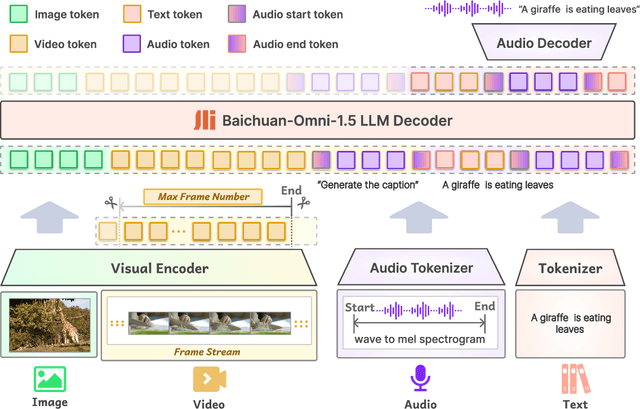
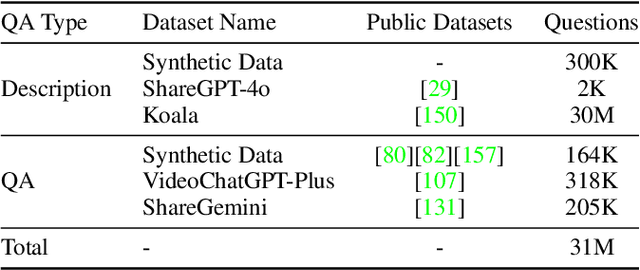
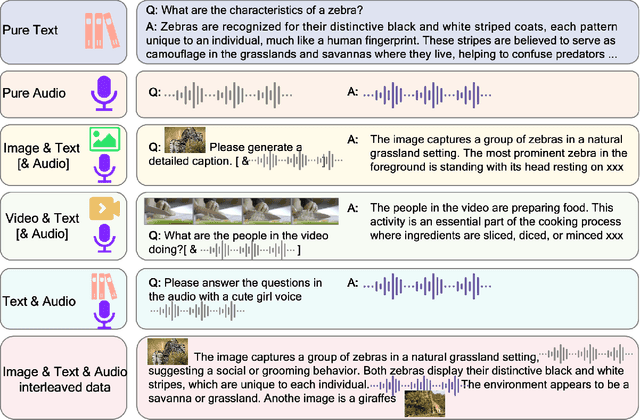
Abstract:We introduce Baichuan-Omni-1.5, an omni-modal model that not only has omni-modal understanding capabilities but also provides end-to-end audio generation capabilities. To achieve fluent and high-quality interaction across modalities without compromising the capabilities of any modality, we prioritized optimizing three key aspects. First, we establish a comprehensive data cleaning and synthesis pipeline for multimodal data, obtaining about 500B high-quality data (text, audio, and vision). Second, an audio-tokenizer (Baichuan-Audio-Tokenizer) has been designed to capture both semantic and acoustic information from audio, enabling seamless integration and enhanced compatibility with MLLM. Lastly, we designed a multi-stage training strategy that progressively integrates multimodal alignment and multitask fine-tuning, ensuring effective synergy across all modalities. Baichuan-Omni-1.5 leads contemporary models (including GPT4o-mini and MiniCPM-o 2.6) in terms of comprehensive omni-modal capabilities. Notably, it achieves results comparable to leading models such as Qwen2-VL-72B across various multimodal medical benchmarks.
Baichuan Alignment Technical Report
Oct 19, 2024



Abstract:We introduce Baichuan Alignment, a detailed analysis of the alignment techniques employed in the Baichuan series of models. This represents the industry's first comprehensive account of alignment methodologies, offering valuable insights for advancing AI research. We investigate the critical components that enhance model performance during the alignment process, including optimization methods, data strategies, capability enhancements, and evaluation processes. The process spans three key stages: Prompt Augmentation System (PAS), Supervised Fine-Tuning (SFT), and Preference Alignment. The problems encountered, the solutions applied, and the improvements made are thoroughly recorded. Through comparisons across well-established benchmarks, we highlight the technological advancements enabled by Baichuan Alignment. Baichuan-Instruct is an internal model, while Qwen2-Nova-72B and Llama3-PBM-Nova-70B are instruct versions of the Qwen2-72B and Llama-3-70B base models, optimized through Baichuan Alignment. Baichuan-Instruct demonstrates significant improvements in core capabilities, with user experience gains ranging from 17% to 28%, and performs exceptionally well on specialized benchmarks. In open-source benchmark evaluations, both Qwen2-Nova-72B and Llama3-PBM-Nova-70B consistently outperform their respective official instruct versions across nearly all datasets. This report aims to clarify the key technologies behind the alignment process, fostering a deeper understanding within the community. Llama3-PBM-Nova-70B model is available at https://huggingface.co/PKU-Baichuan-MLSystemLab/Llama3-PBM-Nova-70B.
4K-Resolution Photo Exposure Correction at 125 FPS with ~8K Parameters
Nov 15, 2023



Abstract:The illumination of improperly exposed photographs has been widely corrected using deep convolutional neural networks or Transformers. Despite with promising performance, these methods usually suffer from large parameter amounts and heavy computational FLOPs on high-resolution photographs. In this paper, we propose extremely light-weight (with only ~8K parameters) Multi-Scale Linear Transformation (MSLT) networks under the multi-layer perception architecture, which can process 4K-resolution sRGB images at 125 Frame-Per-Second (FPS) by a Titan RTX GPU. Specifically, the proposed MSLT networks first decompose an input image into high and low frequency layers by Laplacian pyramid techniques, and then sequentially correct different layers by pixel-adaptive linear transformation, which is implemented by efficient bilateral grid learning or 1x1 convolutions. Experiments on two benchmark datasets demonstrate the efficiency of our MSLTs against the state-of-the-arts on photo exposure correction. Extensive ablation studies validate the effectiveness of our contributions. The code is available at https://github.com/Zhou-Yijie/MSLTNet.
OpenAnnotate3D: Open-Vocabulary Auto-Labeling System for Multi-modal 3D Data
Oct 20, 2023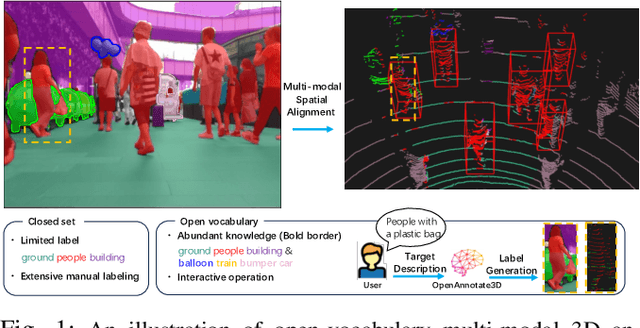
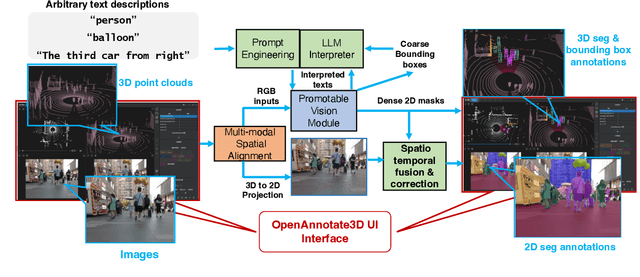
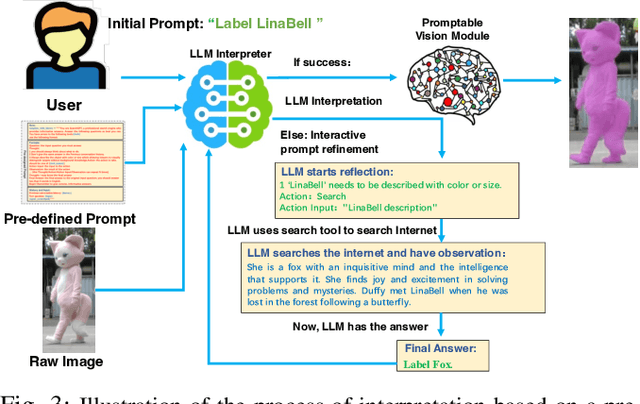
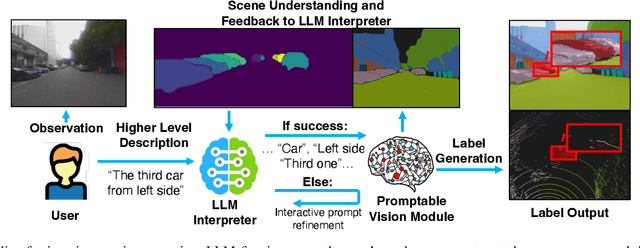
Abstract:In the era of big data and large models, automatic annotating functions for multi-modal data are of great significance for real-world AI-driven applications, such as autonomous driving and embodied AI. Unlike traditional closed-set annotation, open-vocabulary annotation is essential to achieve human-level cognition capability. However, there are few open-vocabulary auto-labeling systems for multi-modal 3D data. In this paper, we introduce OpenAnnotate3D, an open-source open-vocabulary auto-labeling system that can automatically generate 2D masks, 3D masks, and 3D bounding box annotations for vision and point cloud data. Our system integrates the chain-of-thought capabilities of Large Language Models (LLMs) and the cross-modality capabilities of vision-language models (VLMs). To the best of our knowledge, OpenAnnotate3D is one of the pioneering works for open-vocabulary multi-modal 3D auto-labeling. We conduct comprehensive evaluations on both public and in-house real-world datasets, which demonstrate that the system significantly improves annotation efficiency compared to manual annotation while providing accurate open-vocabulary auto-annotating results.
ODSum: New Benchmarks for Open Domain Multi-Document Summarization
Sep 16, 2023



Abstract:Open-domain Multi-Document Summarization (ODMDS) is a critical tool for condensing vast arrays of documents into coherent, concise summaries. With a more inter-related document set, there does not necessarily exist a correct answer for the retrieval, making it hard to measure the retrieving performance. We propose a rule-based method to process query-based document summarization datasets into ODMDS datasets. Based on this method, we introduce a novel dataset, ODSum, a sophisticated case with its document index interdependent and often interrelated. We tackle ODMDS with the \textit{retrieve-then-summarize} method, and the performance of a list of retrievers and summarizers is investigated. Through extensive experiments, we identify variances in evaluation metrics and provide insights into their reliability. We also found that LLMs suffer great performance loss from retrieving errors. We further experimented methods to improve the performance as well as investigate their robustness against imperfect retrieval. We will release our data and code at https://github.com/yale-nlp/ODSum.
Revisiting Cross-Lingual Summarization: A Corpus-based Study and A New Benchmark with Improved Annotation
Jul 08, 2023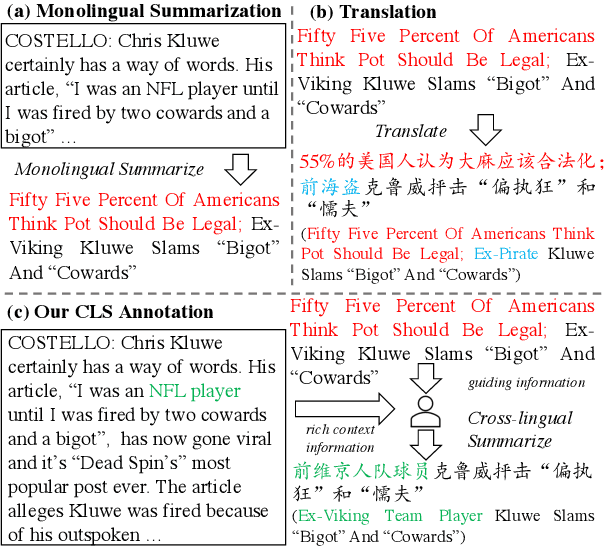
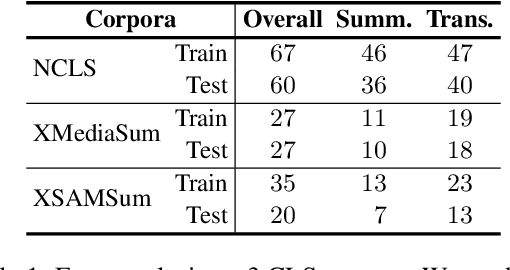
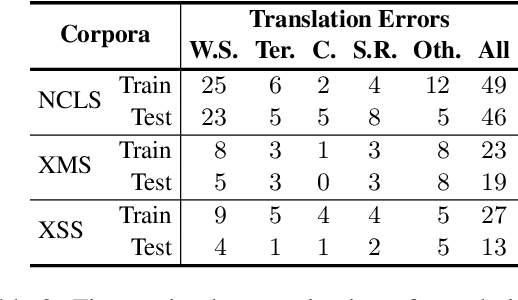
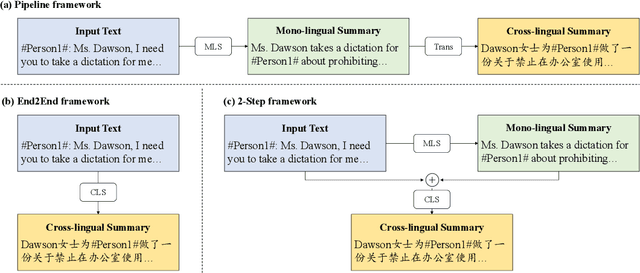
Abstract:Most existing cross-lingual summarization (CLS) work constructs CLS corpora by simply and directly translating pre-annotated summaries from one language to another, which can contain errors from both summarization and translation processes. To address this issue, we propose ConvSumX, a cross-lingual conversation summarization benchmark, through a new annotation schema that explicitly considers source input context. ConvSumX consists of 2 sub-tasks under different real-world scenarios, with each covering 3 language directions. We conduct thorough analysis on ConvSumX and 3 widely-used manually annotated CLS corpora and empirically find that ConvSumX is more faithful towards input text. Additionally, based on the same intuition, we propose a 2-Step method, which takes both conversation and summary as input to simulate human annotation process. Experimental results show that 2-Step method surpasses strong baselines on ConvSumX under both automatic and human evaluation. Analysis shows that both source input text and summary are crucial for modeling cross-lingual summaries.
Human-in-the-Loop Robot Planning with Non-Contextual Bandit Feedback
Nov 03, 2020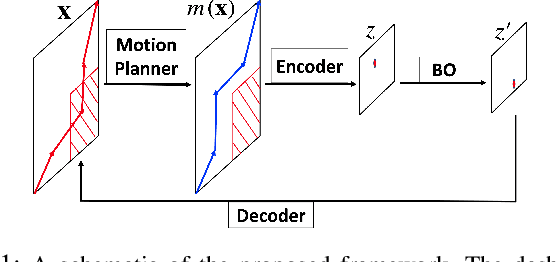
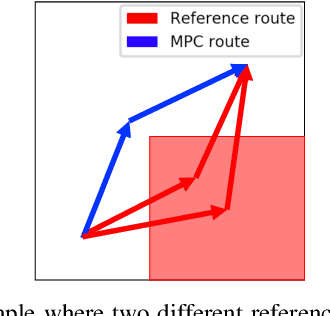
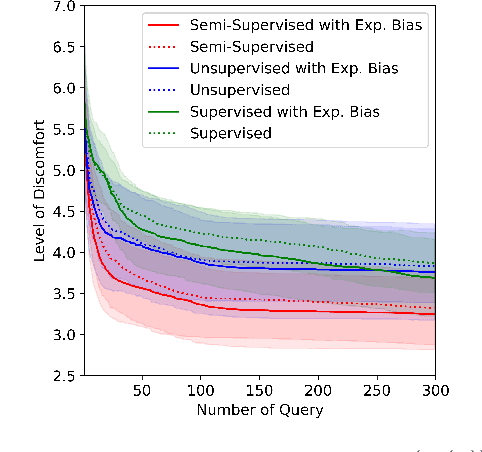
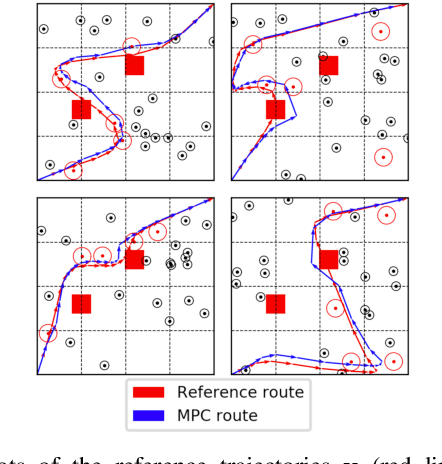
Abstract:In this paper, we consider a robot navigation problem in environments populated by humans. The goal is to determine collision-free and dynamically feasible trajectories that also maximize human satisfaction. This is because they may drive the robot close to humans that need help with their work or because they may keep the robot away from humans when it can interfere with human sight or work. In practice, human satisfaction is subjective and hard to describe mathematically. As a result, the planning problem we consider in this paper may lack important contextual information. To address this challenge, we propose a semi-supervised Bayesian Optimization (BO) method to design globally optimal robot trajectories using non-contextual bandit human feedback in the form of complaints or satisfaction ratings that express how satisfactory a trajectory is, without revealing the reason. Since trajectory planning is typically a high-dimensional optimization problem in the space of waypoints that define a trajectory, BO may require prohibitively many queries for human feedback to return a good solution. To this end, we use an autoencoder to reduce the high-dimensional problem space into a low dimensional latent space, which we update using human feedback. Moreover, we improve the exploration efficiency of BO by biasing the search for new trajectories towards dynamically feasible and collision-free trajectories obtained using off-the-shelf motion planners. We demonstrate the efficiency of our proposed trajectory planning method in a scenario with humans that have diversified and unknown demands.
 Add to Chrome
Add to Chrome Add to Firefox
Add to Firefox Add to Edge
Add to Edge